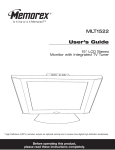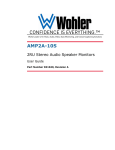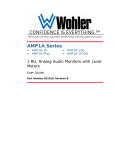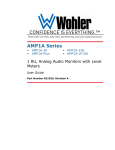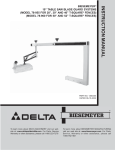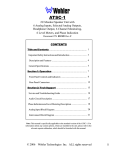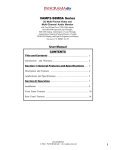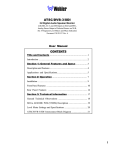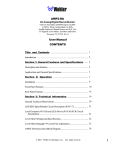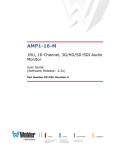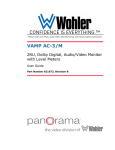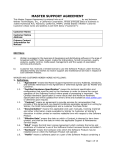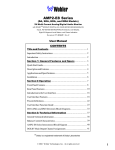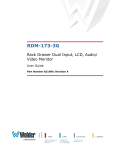Download User Manual
Transcript
CONFIDENCE IS EVERYTHING.™ World Leader of In-Rack, Audio, Video, Data Monitoring, and Closed Captioning Solutions AMPx SDA Series • AMP1-SDA • AMP2-SDA Digital Audio Speaker Monitors User Guide Part Number 821027, Revision C © 2010 Wohler Technologies, Inc. and PANORAMA. All rights reserved. This publication is protected by federal copyright law. No part of this publication may be copied or distributed, stored in a retrieval system, or translated into any human or computer language in any form or by any means electronic, mechanical, manual, magnetic, or otherwise, or disclosed to third parties without the express written permission of Wohler Technologies. Reproduction Licensed users and authorized distributors of Wohler Technologies, Inc. products may copy this document for use with Wohler Technologies., Inc. products provided that the copyright notice above is included in all reproductions. Customer Support Wohler Technologies, Inc. 31055 Huntwood Avenue Hayward, CA 94544 www.wohler.com Phone: 510-870-0810 FAX: 510-870-0811 US Toll Free: 1-888-596-4537 (1-888-5-WOHLER) Web: www.wohler.com Sales: [email protected] Support: [email protected] Disclaimers Even though Wohler Technologies, Inc. has tested its equipment and software, and reviewed the documentation, Wohler Technologies, Inc. makes no warranty or representation, either express or implied, with respect to software, documentation, their quality, performance, merchantability, or fitness for a particular purpose. Wohler Technologies, Inc. reserves the right to change or improve our products at any time and without notice. In no event will Wohler Technologies, Inc. be liable for direct, indirect, special, incidental, or consequential damages resulting from any defect in the hardware, software, or its documentation, even if advised of the possibility of such damages. Some states do not allow the exclusion or limitation for incidental or consequential damages, so the above exclusion or limitation may not apply to you. Printing This document is intended to be printed on a duplex printer, such that the copy appears on both sides of each page. This ensures that all new chapters start on a right-facing page. This document looks best when printed on a color printer since some images may be indistinct when printed on a black and white printer. Other Technologies and Products Dolby, Dolby Digital, Dolby D, and Dolby E are registered trademark of Dolby Laboratories, Inc. Microsoft Windows, and Internet Explorer are registered trademarks of Microsoft Corporation. Last Update March 23, 2010 ii © 2 00 9 Wo h le r Te ch n ol og ie s , I n c . A l l r i g h t s r e s e rve d . AMPx-SDA User Guide Introduction Overview The AMPx-SDA Series of audio monitors provides self-powered, fullfidelity stereo monitoring in the smallest rack space possible. All models in the series contain four high performance transducers driven by three power amplifiers: two amplifier/driver combinations handle midrange and high frequency information in stereo, while the third center channel reproduces information below the 500 Hz crossover point. Topics Topics Introduction Page 1 Safety Instructions 2 Installation Recommendations 3 Features 4 Applications 5 Specifications 6 Front Panel Controls 8 Rear Panel Connectors 11 Technical Functional Overview 16 © 2 01 0 Wo h le r Te ch n o l og ie s, I n c . A l l r i g h t s r e s e r v e d . 1 AMPx-SDA User Guide S a f e t y I n s tr u c ti o n s Safety Instructions IMPORTANT: 1. Read, keep, and follow all of these instructions; heed all warnings. 2. Do not use this equipment near water or moisture. 3. Use only a dry cloth to clean the equipment. 4. Do not block any ventilation openings. Install only in accordance with the instructions in the section entitled, “Installation Recommendations” on page 3. 5. Do not install near any heat source such as a radiator, heat register, amplifier, or stove. 6. Do not attempt to plug the unit into a two-blade outlet (with only two prongs of equal width). By design, these monitors will only plug into a three-prong outlet for your safety. If the plug does not fit into your outlet, contact an electrician to replace the obsolete outlet. 7. Protect the power cord from being walked on or pinched, particularly at plug’s source on the equipment and at the socket. 8. Use only the attachments/accessories specified by the manufacturer. 9. Unplug the equipment during lightning storms or when unused for long periods of time. 10. Refer all servicing to qualified service personnel. Servicing will be required under all of the following conditions: 2 • The equipment has been damaged in any way, such as when the power-supply cord or plug is damaged. • Liquid had been spilled or objects have fallen onto the equipment. • The equipment has been exposed to rain or moisture. • The equipment does not operate normally. • The equipment has been dropped. © 2 01 0 Wo h le r Te ch n ol og ie s , I n c . A l l r i g h t s r e s e rve d . AMPx-SDA User Guide I n s ta l la t i o n R e c o m me n d a t io n s Installation Recommendations Mounting Note: If you wish to set the AES Input Termination, AES Status Error Type, AES Input Level Gain, Line Level Calibration, Meter Gain Calibration, and/or Bargraph Display Mode via the DIP switches (accessed on the rear panel) be sure to do so BEFORE installing the unit into an enclosed rack or console. See pages 12 and 14 for setting information. The unit should be mounted where convenient for operating persons, ideally at approximately ear level for best high frequency response. Its superior magnetic shielding eliminates concerns about locating it adjacent to most types of CRT monitors, including even high-resolution color monitors. Heat Dissipation Heat dissipated by the speaker amps is conducted directly to the left side of the chassis; no special considerations for cooling are necessary as long as the ambient temperature inside the rack area does not exceed approximately 40°C (104°F). Sympathetic Vibration Sympathetic vibration from other equipment (cables, etc.,) in the rack may be serious enough to interfere with the unit’s sound quality out in the listening area. The use of thin card stock and/or felt or foam weather-stripping type materials between adjacent vibrating surfaces, or tying up loose cables, etc., may be required to stop vibrations external to the unit. Mechanical Bracing Even though the unit is fairly heavy, the chassis is securely attached to the front panel at eight points along its surface, not just at the four corners of the chassis ears. This feature will reduce or eliminate rear bracing requirements in many mobile/portable applications. The weight of internal components is distributed fairly evenly around the unit. © 2 01 0 Wo h le r Te ch n o l og ie s, I n c . A l l r i g h t s r e s e r v e d . 3 AMPx-SDA User Guide Features Audio Connections Connection of the audio feeds is straightforward. For digital inputs, Impedances are 75 Ω for the unbalanced BNC connectors and 110 Ω for the balanced XLR connectors. Analog inputs have an impedance of 40k Ω for the balanced XLR connectors. Care should be exercised to avoid mismatched cable types and other similar causes of undesired reflections in RF signal systems. Electrical Interference As with any audio equipment, maximum immunity from electrical interference requires the use of shielded cable; however, satisfactory results can sometimes be obtained without it. The internal circuitry common is connected to the chassis. AC Power The unit's AC mains connection is via a standard IEC inlet, with safety ground connected directly to the unit's chassis. The universal AC input (100-240VAC, 50/60Hz) switching power supply is a self-resetting sealed type, with automatic over-voltage and over-current shutdown. There is no user-replaceable fuse in either the primary or secondary circuit. Features • Excellent high frequency response for positive detection of background whine and noise • Audible and visual indication of phase/polarity problems • Thorough magnetic shielding for placement next to video monitors • Two high-resolution 26-segment tri-color LED bar graph level meters • SDI input and loop-through on unbalanced BNC connectors 4 © 2 01 0 Wo h le r Te ch n ol og ie s , I n c . A l l r i g h t s r e s e rve d . AMPx-SDA User Guide Applications • AES/EBU input on unbalanced BNC connector • Analog stereo inputs on two balanced XLR connectors • AES output (converted from SDI input) on BNC connector • Analog output of selected input on two balanced XLR connectors • SDI signal status indication LED • AES signal status indication LED • SDI subgroup 1 or 2 (of Group #1) source selection via front panel toggle switch • SDI/AES source selection via front panel toggle switch • Digital/analog source selection via front panel toggle switch • Headphone output • Power indication LED Applications The AMP1 Digital series is ideally suited for use in VTR bays, mobile production vehicles, teleconferencing installations, multimedia systems, satellite links and cable TV facilities, and on-air radio studios. Designed and manufactured in the U.S., the AMP1-SDA is backed by a strong warranty and a satisfaction guaranteed return policy. © 2 01 0 Wo h le r Te ch n o l og ie s, I n c . A l l r i g h t s r e s e r v e d . 5 AMPx-SDA User Guide S p e c if i c a ti o n s Specifications Table 1–1 Audio Specifications for the AMPx-SDA Series Monitors Specifications AMP1-SDA Analog IN: XLR (3-pin female) 2 each SDI IN: BNC (female) 1 each AES IN: BNC (female) 1 each XLR: 110 (Balanced) BNC: 75 (Unbalanced) XLR: 40k (Balanced) Input connectors Digital input impedance Analog input impedance Input Level for Maximum Output (Volume Full On) Input Overload Peak Acoustic Output (@ 2 ft.) AMP2-SDA 0 dBv balanced +26 dBv balanced 98 dB SPL 104 dB SPL 80 Hz - 16 kHz ± 7 dB) 80 Hz - 16 kHz ± 5 dB) (-10 dB @ 50 Hz, 22 kHZ) (-10 dB @ 40 Hz, 20 kHZ) 10 W transient / 5 W continuous 14 W transient / 10 W continuous RMS Bass (4 ) 20 W transient / 10 W continuous 35 W transient / 25 W continuous Distortion, Electrical: < 0.15% at any level below limit threshold 8% or less at worst case 6% or less at worst case frequencies above 180 Hz frequencies above 120 Hz, including cabinet including cabinet resonance; typically less resonance; typically less than 2% than 1.5% better than -68 dD below full output < 1 Gauss any adjacent <0.8 Gauss any adjacent surface surface Response, Sixth Octave: Power Output RMS Each Side (4 ) Distortion, Acoustic: Hum and Noise Magnetic Shielding: Power Consumption (Average Maximum): AC Mains input: 6 35 W 45 W 100-240VAC, 50-60 Hz © 2 01 0 Wo h le r Te ch n ol og ie s , I n c . A l l r i g h t s r e s e rve d . AMPx-SDA User Guide S p e ci f i c a t i o n s Table 1–2 Physical Specifications for the AMPx-SDA Series Monitors Specifications AMP1-SDA Dimensions (H x W x D) Weight Table 1–3 D to A gain calibration, (dBu = dBFS): AES sampling rate: D to A converter: Converted analog out (S/N): Converted analog out (THD): AES Termination: Level Meter Type: Level Calibration Frequency Response LED Segment Colors Metering Range: Display Modes: VU Characteristics, Rise Time: Decay Time: PPM Characteristics, Decay Time: Meter dynamics: 3.5 x 19 x 12 inches 44 x 483 x 305 mm 14 lbs. (6.4 kg) (89 x 483 x 305 mm) 18 lbs. (8.2 kg) AMP1-SDA AMP2-SDA +8 = -20, +4 = -20, +6 = -9, 0 = -18 (swtich selectable) 32 to 48 kHz, auto-select 24-bit low jitter >90 dB < 0.008% 75removable, unbalanced Meter Specifications for the AMPx-SDA Series Monitors Specifications Attack Time: 1.75 x 19 x 12 inches Digital to Analog Specifications for the AMPx-SDA Series Monitors Specifications Table 1–4 AMP2-SDA AMP1-SDA AMP2-SDA 26-segment tri-color LED 53-Segment LED bargraph bargraph display 0, +4, +6, +8 dBv 20 Hz to 20 kHz (±0.5 dB) Tricolor (red, amber, green) 65 dB VU with PPM or Peak Hold (Select) 300 ms to 99% of full indication 300 ms 10 ms 2 seconds, 0 to -20 dB VU (bar) and/or PPM (dot), select © 2 01 0 Wo h le r Te ch n o l og ie s, I n c . A l l r i g h t s r e s e r v e d . 7 AMPx-SDA User Guide Front Panel Controls Table 1–4 Meter Specifications for the AMPx-SDA Series Monitors Specifications AMP1-SDA AMP2-SDA PPM: 20 dB decay in 1.5 sec. or 3 sec hold VU: 3 sec. hold or 10 sec. hold 1 dB 2 dB +16 to -50 dB .158" x .04" (4.0132 x 1.016 mm) Dynamics modes: Midscale resolution: Scale Segment size: Front Panel Controls Figure 1–1 AMP1-SDA Front Panel AES Power Volume Headphones Brightness Phase Level Meters Balance SDI Analog/Digital AES/SDI SDI Group Speakers Figure 1–2 Power AMP2-SDA Front Panel Brightness Volume Phase Level Meters Headphones Analog/Digital Balance Sub-Group AES/SDI Speakers 8 © 2 01 0 Wo h le r Te ch n ol og ie s , I n c . A l l r i g h t s r e s e rve d . AMPx-SDA User Guide Front Panel Controls • Speakers: The internal speaker system is comprised of two midrange tweeter speakers (left and right) and woofer speakers. The AMP1-SDA has two woofers wired in series and the AMP2-SDA has one larger woofer. The two side channel speakers reproduce, in stereo, only the mid and high frequencies. Please note that the woofer speaker (center) is not a dedicated center nor LFE speaker. • Power Indication LED: This LED glows green to indicate the AMPx-SDA is connected to mains power and an operation voltage is present. • Audio Level Meter LED Bar Graphs: Audio levels for the selected source (right and left) are visually displayed via these two highresolution, tricolor LED bargraph meters. Dynamic range for these meters is 65 dB and they are able to simultaneously display signal levels using both PPM and VU standards. Alternate display modes are user selectable via a DIP switch accessible through the top cover of the unit. Contact the factory for additional information concerning meter scales and ballistics. • Volume: This controls the loudness of the audio reproduced by the internal speakers or connected headphone. Clock-wise rotation of this control increases the loudness of the monitored audio. • Headphones: Select the headphone audio sources as you would for the internal speakers. When you plug in headphones, the internal or external speakers will mute. This jack accepts a standard 1/4” phone type stereo plug. • Analog/Digital Source Select: This two position toggle switch allows the operator to choose between two primary input sources; Analog or Digital. When this toggle switch is set to Analog, the unit will monitor the signals as input on the two rear panel Analog In XLR connectors. When this toggle switch is set to Digital, the unit will monitor one of two types of digital signal sources as chosen by the Digital Source Select switch. • Bar Graph Brightness: This control is recessed into the front panel and can be accessed using a small screwdriver. Turning it clockwise will increase the relative brightness of the bargraph display LED segments. Adjusting this one control will simultaneously affect the brightness of both bargraph displays on the front panel. • Phase Indication LEDs: These three LEDs offer instant verification of phase (polarity) conditions in the pair of channels selected for monitoring in the left/right channel speakers. There are three LEDs; the © 2 01 0 Wo h le r Te ch n o l og ie s, I n c . A l l r i g h t s r e s e r v e d . 9 AMPx-SDA User Guide Front Panel Controls two smaller LEDs labeled Fast (left side of the Phase section) show instantaneous phase relationships in the signal, while the larger LED, labeled Avg (right side of the Phase section), will indicate the average phase condition. The small Fast LED on the left glows (or blinks) green when signals are in-phase. The small Fast LED on the right glows (or blinks) amber for out-of-phase signals. The larger Avg LED indicates the average phase condition by glowing green for in-phase conditions, or red for out-of-phase conditions. In general, it is sufficient to regard the Avg LED (average phase condition) as adequete for proper phase monitoring. While it is normal for stereo signals to contain some intermittant instanateous out-of phase and in-phase conditions (small LEDs), a steady red glow of the larger LED almost always indicates an outof-phase alarm condition. • Balance: This pans the volume balance between the left and right speakers. If the balance is adjusted hard left or hard right, a slight left/right channel mix is retained (only in low bass frequencies) so that phase discrepancies can be discerned. • SDI Subgroup Select (1 or 2): This 2-position toggle switch allows the operator to choose whether the unit will monitor sub-group 1 or sub-group 2 of the SDI data stream when the Digital Source Select switch is set to SDI. Subgroup selections 1 and 2 are derived from Group 1 as follows: • Subgroup 1 = Channels 1 and 2 • Subgroup 2 = Channels 3 and 4 • Digital Signal Error LEDs: These two bi-color (Green/Red) LEDs indicate the input presence and status of the two types of digital signals; AES and SDI. These LEDs function whether or not either of the digital signals is selected for monitoring through the unit. • 10 AES Signal Error LED: This LED, labeled AES, glows green as long as a valid AES/EBU digital datastream is being received. It glows red to indicate errors. By setting a rear panel DIP switch, two types of error detection are available: 1) Reception errors: errors in reception of data or no data stream at all, or 2) Reception and data errors: errors in reception and data errors identified by the sending device (possibly invalid). © 2 01 0 Wo h le r Te ch n ol og ie s , I n c . A l l r i g h t s r e s e rve d . AMPx-SDA User Guide Rear Panel Connectors • SDI Signal Error LED: This LED, labeled SDI glows green as long as a valid SDI digital datastream is being received. It glows red if TSR errors are present in the signal. If there is no SDI signal present the LED will be unlit. Rear Panel Connectors Common Connectors • Power: Attach a standard IEC-320 power cord between this connector and mains power (100 - 250VAC, 50/60 Hz). The front panel Power LED will glow green to indicate operating voltages are present. • AES Out (From SDI): The AES/EBU Out outputs an AES/EBU signal as converted from the SDI input and as selected by the SDI Group Select switch. This connector is configured for an unbalanced, 75 W connection. • AES Termination and Error Type DIP Switch: This 4-position DIP switch is used to set the termination characteristics for the AES inputs and select the AES signal error indication type. • AES Input Termination: In the event that the AES input channel is fed to downstream equipment (via a "Y" or "T" connector), then DIP switch Section S2 must be placed in the unterminated (up) position. If there is no downstream equipment connected, then Section S2 must be placed in the terminated (down) position. See Figure 1–3 below termination settings. Figure 1–3 AES Termination Settings © 2 01 0 Wo h le r Te ch n o l og ie s, I n c . A l l r i g h t s r e s e r v e d . 11 AMPx-SDA User Guide R e a r P a n e l C o n n e ct o r s Note • Position 3 is not used. AES Error Indication Type: There are two DIP switch selectable modes of AES error detection that will create a RED error indication in the AES Signal Error Indication LED on the front panel; 1) Reception errors: errors in reception of data or no data stream at all (S1=Down), or 2) Reception and data errors: errors in reception and data errors identified by the sending device (possibly invalid) (S1= Up). See Figure 1–4 for AES error DIP switch settings. Figure 1–4 AES Error Indication Settings • AES Input Connector: The AES/EBU IN input connector is meant to receive standard AES/EBU signals. This female BNC connector is configured for an unbalanced, 75 connection. Note that the unit will monitor the AES/EBU In input only when the Analog/Digital Source Select switch is set to Digital and the Digital Source Select switch is set to AES. • AES Input Level Gain Calibration DIP Switch: Input Level Gain Calibration, the analog level which corresponds to a given digital input value, is settable via this DIP switch. The factory setting is +4 dB (analog) = -20 dBFS (digital). See the silk-screened chart on the rear panel or the diagram below for gain calibration settings. 12 © 2 01 0 Wo h le r Te ch n ol og ie s , I n c . A l l r i g h t s r e s e rve d . AMPx-SDA User Guide Rear Panel Connectors Figure 1–5 AES DA Conversion Gain Calibration Settings • SDI In and Out: The SDI In female BNC connector is meant to receive standard SDI signals. The SDI Out female BNC connector outputs a reclocked (regenerated) copy of the signal entering the SDI In input connector. Both connectors are configured for unbalanced, 75 Ω connections. Note that the unit will monitor the SDI input only when the Analog/Digital Source Select switch is set to Digital and the Digital Source Select switch is set to SDI. • Selected Analog Out (from Digital Source): These two 3-pin male XLR connectors are analog outputs of the selected digital source as selected for the left and right speakers and level meters. The left connector outputs the left channel (or Channel A) and the right outputs the right channel (or Channel B). Both connectors are configured for low impedance connections and the output signals are not affected by the Volume/Balance controls or headphone mute. For XLR pinout information see Figure 1–6 below. Figure 1–6 XLR Pin-Outs Female Male © 2 01 0 Wo h le r Te ch n o l og ie s, I n c . A l l r i g h t s r e s e r v e d . 13 AMPx-SDA User Guide R e a r P a n e l C o n n e ct o r s • Analog In: These two 3-pin female XLR connectors accept standard analog audio signals. Both connectors are configured for balanced 40k Ω connections. Note that the unit will monitor analog signals input on these two connectors only when the Analog/Digital Source Select switch on the front panel is set to Analog. For XLR pinout information see the Figure 1–6 on page 13. AMP1-SDA-Specific Connectors Figure 1–7 AMP1-SDA Rear Panel Power AES/EBU IN SERIAL NO. AES/EBU OUT AES/EBU Out GAIN CALIB AMP1-SDA 253830 DIGITAL GAIN CALIB dB dBFS +8 -20 IN OUT SDI SDI Out SDI In +4 -20 +6 -9 0 -18 METER CALIB DISPLAY MODE Calibration VU/VU OPERATE +6 VU/PPM CALIBRATE +4 PPM +8 0 23 PPM/PPM 45 Analog In FROM DIGITAL SOURCE SEL. OUT CH A(L) Wohler Technologies www.Wohler.com TERM 2 Tel +1-510-870-0810 Fax +1-510-870-0811 X ANALOG IN CH A(L) TERM 1 ERROR INTERNAL POWER SUPPLY APPROVED BY UNDERWRITERS LABS SEE POWER SUPPLY LABEL ON SIDE 100-240 VAC 50/60 Hz ANALOG IN CH B(R) AES/EBU In Gain/Calibration AES Termination 1 2 3 14 Selected Analog Out from Digital Source Rear Panel DIP Switch Settings © 2 01 0 Wo h le r Te ch n ol og ie s , I n c . A l l r i g h t s r e s e rve d . 2 3 123456 • Level/Gain Calibration and Display Mode - 6-Position DIP Switch: This DIP switch sets the Line Level Calibration, Meter Gain Calibration, and Bar Graph Display Mode. Figure 1–8 1 AMPx-SDA User Guide Rear Panel Connectors • Line Level Calibration: The unit is calibrated at the factory. To recalibrate: 1) Turn on the power. 2) Apply a reference level (nominal 0) signal to all four channels. 3) Make sure the Gain Calibration DIP sections (S2, S3) are set to the nearest level (i.e., 0, +4, +6 or +8). 4) Place section S1 of the DIP switch in the DOWN position. 5) Wait 10 seconds. The unit will remove the previous calibration. The unit will make sure that all four channels are within ±4 dB of nominal zero. If all four channels are within this range then the new calibration will be applied. If any channel is outside this range then no new calibration will be applied. 6) Place section S1 of the DIP switch in the UP position and return unit to service. If you want to calibrate again, turn off the power to the unit and repeat steps 1 through 6. See Figure 1–8 on page 14 for settings. • Meter Gain Calibration: DIP switch sections S2 and S3 determine the Gain Calibration, which adjusts the level of the input signal and the resultant "0" level displayed on the LED bargraphs. Factory setting is +4 dB. See Figure 1–8 on page 14 for all settings. • Bar Graph Display Mode: DIP switch sections S4 and S5 determine how peak levels are displayed for the four associated meters on the front panel. S4 selects either the PPM level or a new auto-reset Peak Hold of the VU level (not the PPM value). When S3 is set for VU Peak, S5 sets the Hold time to either 3 or 10 seconds. If S4 is set for PPM Peak, S5 determines whether it is displayed in the original floating PPM dot mode (no hold, continuous decay of 20 dB in 1.5 seconds) or as a 3 second auto-reset hold. The factory default setting is PPM Peak - No Hold (continuous decay of 20 dB in 1.5 seconds). See Figure 1–8 on page 14 for all settings. Note that section S6 on the DIP switch is not used. © 2 01 0 Wo h le r Te ch n o l og ie s, I n c . A l l r i g h t s r e s e r v e d . 15 AMPx-SDA User Guide Technical Functional Overview AMP2-SDA-Specific Connectors Figure 1–9 AMP2-SDA Rear Panel Gain/Calibration Error Type Wohler Technologies Tel +1-510-870-0810 Fax +1-510-870-0811 www.Wohler.com SERIAL NO. AES/EBU OUT MONTH GAIN CALIB. AMP2-SDA 253338 +8 -20 +4 -20 +6 -9 0 -18 CH. A (L) FROM DIGITAL SOURCE IN OUT 1 2 CH. B (R) 1 3 CH. A(L) CH. B (R) 2 3 S 100-240 VAC 50/60 Hz 1.0 A DIGITAL GAIN CALIB dB dBFS AES/EBU IN ERROR TERM 1 TERM 2 X YEAR SDI Power SELECTED ANALOG OUT AES/EBU Out SDI Out AES/EBU In SDI In ANALOG IN Analog In Selected Analog Out from Digital Source Technical Functional Overview Figure 1–10 below illustrates the overall functionality of the AMPx-SDA Series monitors. Figure 1–10 AMPx-SDA Block Diagram L R 53-Segment High-Resolution Level Meters VolumeBalance Analog Input 1 Analog Input 2 AES Input AES Out (from SDI) SDI Output SDI Input 16 Headphone AES SDI/AES Select AES SDI SDI to AES Convertor (with Sub-Group Selector) SDI Analog/ Digital Select A D Digital to Analog Converter L A Stereo Analog Amplifier Left Speaker Woofer Speaker D R Phase Indication © 2 01 0 Wo h le r Te ch n ol og ie s , I n c . A l l r i g h t s r e s e rve d . Right Speaker




















